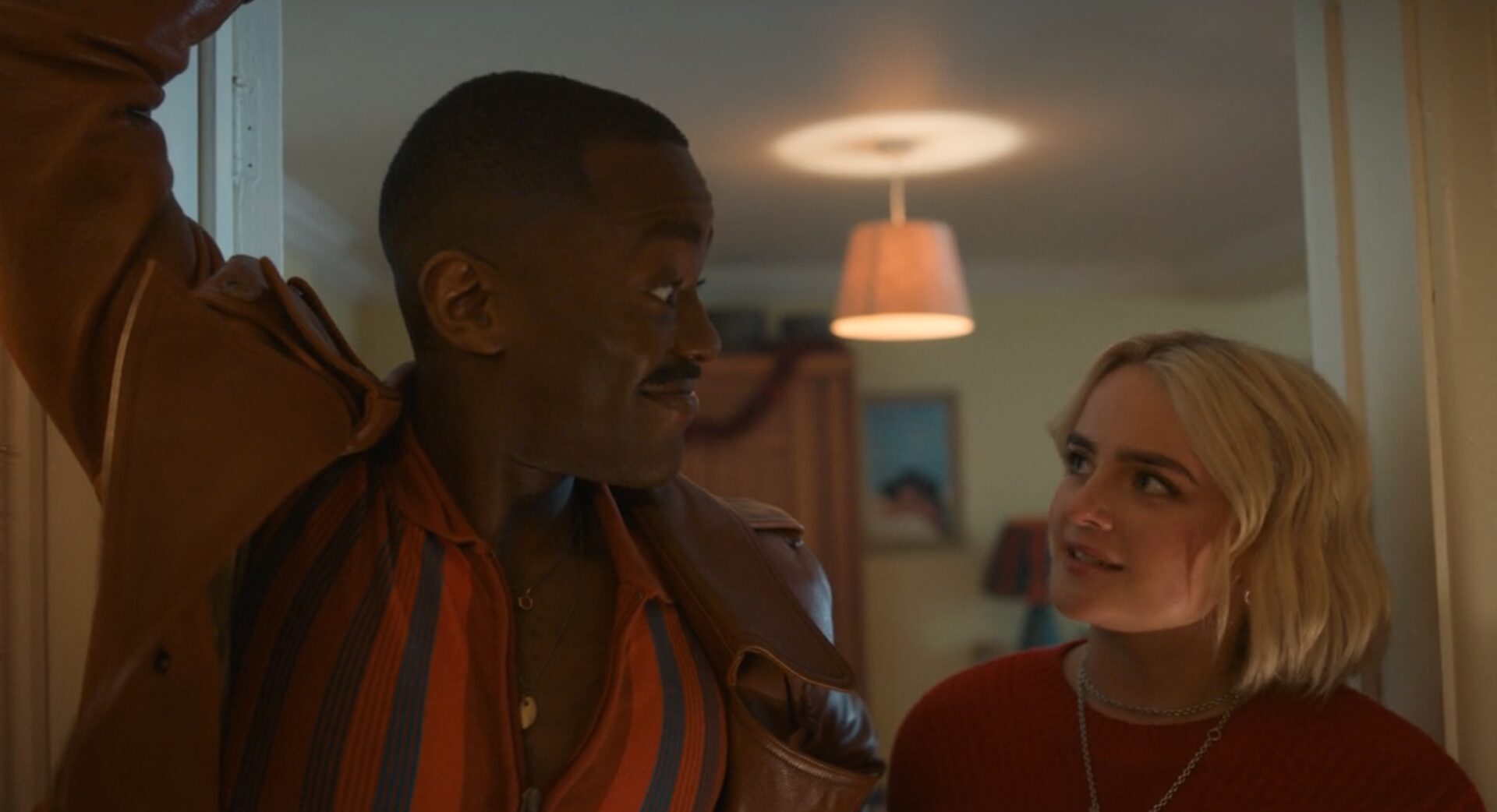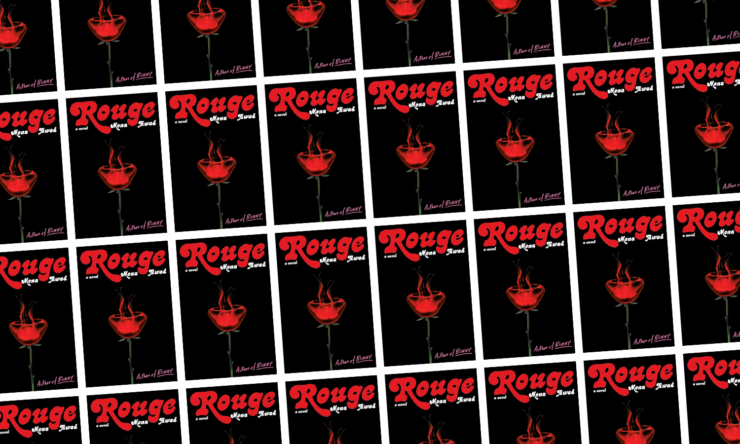If you read Mona Awad’s Bunny, it probably lives rent-free in your head. The story of a very unusual MFA cohort, Bunny is creepy and bloody and made up of bits of fairy tales and mythology and pop culture, all sewn together with the particular genius of Awad’s prose, her way of looking at the world a bit askance. It’s hard not to feel that she sees through things in a way that is simply not available to us ordinary folks—straight through to blood, and viscera, and the ugly feelings that no seventeen-step skincare ritual could ever cover up.
That feeling is even stronger in Rouge, which is also a horror-tinged satire that even at its darkest and sharpest has great understanding of—and sympathy for—its disaster of a protagonist. Recently orphaned Mirabelle Nour has little in her life beyond a skincare obsession and a job in a dress store that’s a shadow of the glitzy shop her glamorous mother owns in California. When her mother dies suddenly, Mira heads west to pay her respects (sort of) and take care of her mother’s estate (such as it is). But there are too many mirrors, all of them cracked, in her mother’s condo, and there’s a very strange sort of spa just down the path, along the cliffs. So strange, in fact, that her mother’s red shoes straight-up lead her there.
The first sentence of Rouge’s prologue tells a reader a great deal of what they need to know: “She used to tell you fairy tales at night, remember?” Remember? The prologue is full of question marks, of fairy tales and spiders and mirrors, red throats and red hair and red roses. It’s unsettling, distant and immediate at once, and in it, Mira is called “Belle,” which is what her mother calls her. Not the mirror part of her name. The beauty part. The emphasis is clear. The meaning takes a while longer.
Languidly, disconcertingly, Rouge takes its time; Awad needs to lay out all the ingredients in her spell, all the things Mira uses on her face: Botanical Resurrection Serum, Diamond-Infused Revitalizing Eye formula, Orpheus Flower Peptide Complex, Dewy Bio-Radiance Snow Mushroom Mist, and so many more. One of those things is prone to making its user tear up. Surely that’s not ominous at all.
And neither is the name of the salon down the way: La Maison de Méduse. There, a client might go on a Journey to become her Most Magnificent Self. (Awad’s precise use of language, of slippery words and important capital letters, is itself Most Magnificent.) Just a few treatments. Quite cutting edge, really. Or very ancient, if you’re more inclined that way. Just trade a few bits of yourself and all your dreams will come true.
Rouge is full of old tales—from the likes of Grimm, from Disney, from old Hollywood. There’s a detective named Hud Hudson and there are California Types (a surfer bro; beige-clad and disapproving women) that Awad turns on their heads, or at least sideways. Like her previous novels, Rouge starts somewhere quite familiar, then wanders deep into the woods, far off the path. If you look at a single scene, a single reference, you might know exactly whence it came—but the fullness and strangeness of what Awad creates with her familiar elements is uniquely surreal.
Buy the Book


Rouge
And it’s also brilliantly balanced. Mirabelle is really going through some stuff—not just her mother’s death, but also the reliving of traumatic childhood memories that may or may not include a fair amount of grooming by an actual devil, or demon, or generally malevolent entity. She is also going through her treatments at the fancy spa, which leave her forgetful and dazed. If you are a person who, like me, can barely watch the kind of comedy that is about people doing humiliating things for us to laugh at, you may struggle through the middle part of the book, in which Belle, dreamy and forgetful, repeats certain mortifying actions. It is excruciating, and Awad is an architect of this particular kind of agony, leaving just the right amount of room for sympathy to slip in around the dread. The discomfort is palpable, but Awad won’t allow you to scorn or mock. You are there to witness, and to flinch.
But even more, Rouge walks a careful line between skincare mockery and skincare understanding. Awad has spoken in interviews about her own obsession with skincare; she clearly knows of what she speaks. Which means she knows just how insidious the language can be, and here, she weaponizes that: the glow, the brightening, the words “I envy,” the way all the words combine to mean pale and white and young. Nubile, in a very specific way that half-Egyptian Mirabelle is unlikely to ever be seen. Her mother pretends to admire Mira’s skin, but Mira knows it’s a lie.
This mother-daughter relationship is the stuff of wicked stepmothers and conniving mirrors, but it’s also rich, and deep, and full of empathy: Noelle des Jardins, with her elegant French name, was a single mother who worked in a department store and dreamed of Hollywood. Even through the eyes of her unhappy daughter, her story is its own sad fairy tale about a woman who could not have what she wanted and could not bear, for a long time, to be around her daughter, her young daughter, all that youth and potential. Awad is clear-eyed and sure in the way she observes these two, their dance of envy and grief, the way there’s always a space the size of Mira’s dead father between them. And when she brings them together, eventually, their forgiveness is beautiful.
Rouge is rich with ideas, almost overripe at times, though intentionally so. It creates a vivid feeling of too much, of both wanting too much and wanting less, wanting to stop wanting. In all the angles of envy and longing, there is a thick, murky drop of dissatisfaction, which is what we’re being sold with every skin care product, every item that promises to fix something about our selves. We must be dissatisfied! We do not have all the things! We do not have the glow! And if we aren’t yet dissatisfied, well, we just need to be shown how things could be better. How we could be better. Don’t we all want to be our Most Magnificent Selves?
Awad is a genius chronicler of need, of desire, of beautiful surfaces hiding messy, bloody truths. What she gets at is the sticky, difficult project of acceptance—not a trite, new-agey sort of “love yourself” bumper-sticker acceptance, but the ongoing effort that is being who you are, and who you want to be, in a world that wants you to keep believing you’re doing it wrong. What do we lose when we refuse to accept ourselves, when we keep telling ourselves we’re wrong and not good enough? What shadows and ghosts do we become?
Rouge is published by Simon & Schuster/Marysue Rucci Books.
Molly Templeton lives and writes in Oregon, and spends as much time as possible in the woods. Sometimes she talks about books on Twitter.










